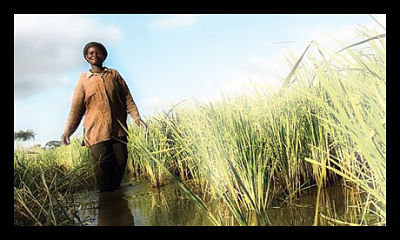Crop Price Insurance for Farmers in Ghana

According to Innovations for Poverty Actions (IPA), 50 percent of the rural population in Ghana lives in poverty. “In the Eastern Region, where the Mumuadu Rural Bank (MRB) operates, an estimated 70 percent of households make a living in the agricultural sector, but agricultural loans make up only 2 percent of the bank’s loan portfolio.”
Why? Because farmers are reluctant to take on loans out of fear that fluctuations in crop prices might lead them to default, while banks worry that the risks associated with farming might fall back on them.
Price fluctuations due to factors external to farm-holding directly affect farmers, who often barely have enough to pay for their own family’s survival. Baseline surveys suggest that there is an unexploited market for crop insurance as “farmers in the area served by MRB express that they would be willing to pay to guarantee a certain minimum crop price.”
Nevertheless, in addition to their reluctance to provide loans due to the associated risks, banks also face incomprehension from farmers because “insurance is not a commonly understood concept among farmers in the region.”
In coordination with the MRB, a system of loans, including a crop insurance parameter, was introduced in the region in order to ensure a form of insurance against low crop prices. The system went like this: if the price for eggplant fell below the 10th percentile of historical prices and the price of maize fell below the 7th percentile of historical prices, the bank would forgive 50 percent of the loan and interest payments.
The goal of introducing price insurance for maize and eggplant was to enable farmers to reduce the risk of investing in agricultural input and improve their harvesting capacity and technology. Eggplant and maize were targeted because both plants are widely grown in the region and have had volatile, but well documented prices.
The average loan size is $159, a substantial cash flow for a farmer in Eastern Ghana. The project was conducted at no cost among 84 farmers, and researchers at the MRB have been able to draw conclusions from the crop insurance experiment.
Although the sample size was small, crop insurance tended to be adopted by older people who had a record of borrowing. The reduced success of crop insurance might be explained by a lack of understanding of the risks and benefits associated with loans, or by the fact that price fluctuations might not be as important for investment as had so far been believed.
The MRB experiment conducted in Ghana paves the way toward improving agriculture in poor rural regions. Once the ideal loan and insurance system is established and once farmers are fully able to understand it, there is hope that farmers might invest in long-lasting technologies that will considerably improve their harvesting capacity. But, for farmers to make long-term investments, crop price fluctuation risks must be reduced to the maximum.
– Lauren Yeh
Sources: Innovation for Poverty Action, SOW
Photo: The Guardian
